Competitive Strategy Analysis of Australian Retail Industry: HI6006
VerifiedAdded on 2023/03/23
|14
|3318
|83
Report
AI Summary
This report presents a competitive strategy analysis of the Australian retail industry, focusing on the rivalry between Woolworths and Coles. The analysis begins with an executive summary and an introduction to the industry's dynamics, highlighting the dominance of these two major players and the impact of emerging competitors like Aldi. The report then summarizes the case study, identifying strategic issues such as price wars, market share competition, and the influence of marketing campaigns. The business strategies of Woolworths and Coles, including their core principles and strategic priorities, are then examined. Finally, Porter's Five Forces framework is applied to assess the competitive landscape of the Australian retail market, considering the bargaining power of buyers and suppliers, the threat of new entrants, and the intensity of rivalry. The report concludes with a summary of findings, emphasizing the challenges faced by smaller organizations and the importance of differentiation in this competitive environment.
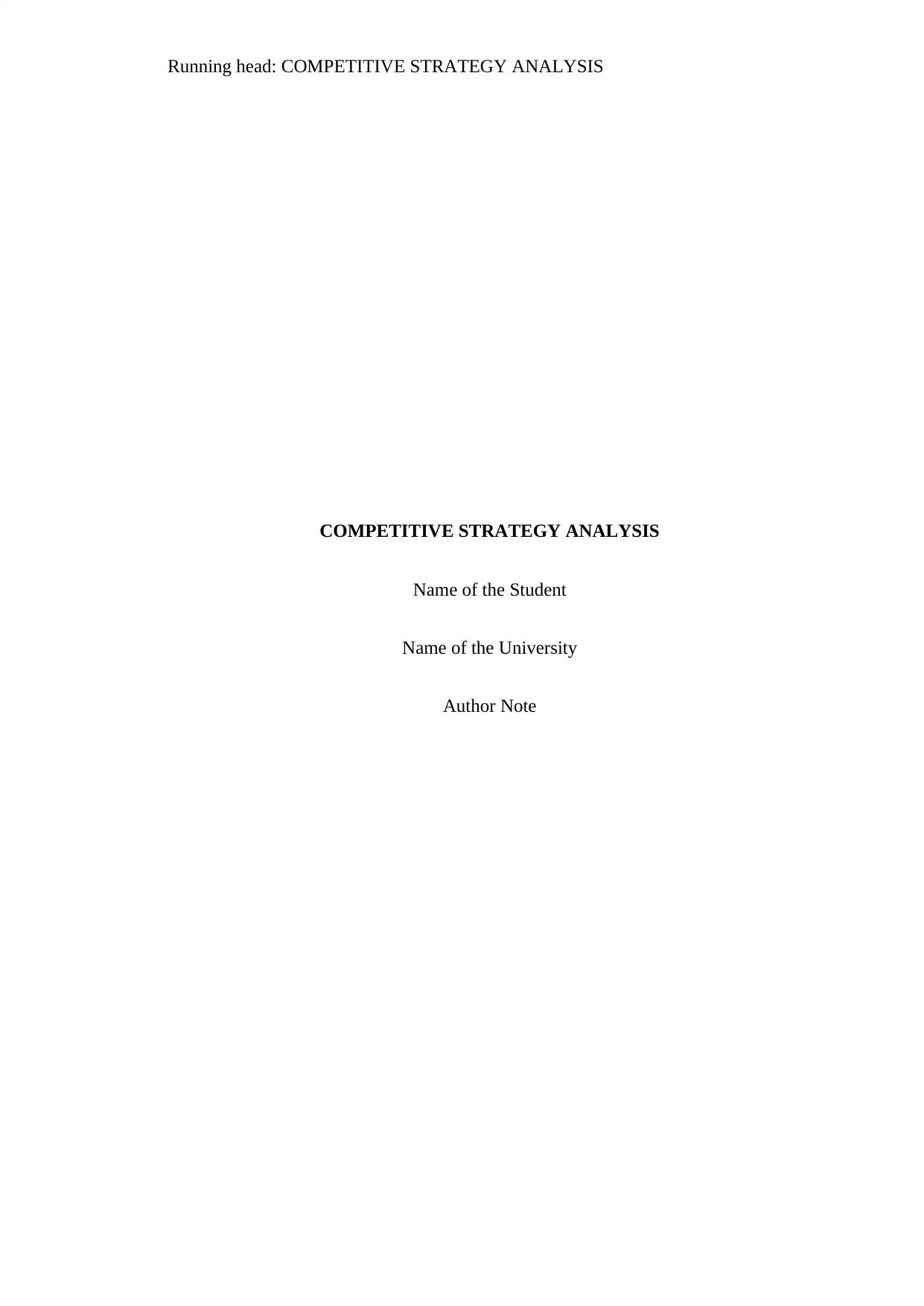
Running head: COMPETITIVE STRATEGY ANALYSIS
COMPETITIVE STRATEGY ANALYSIS
Name of the Student
Name of the University
Author Note
COMPETITIVE STRATEGY ANALYSIS
Name of the Student
Name of the University
Author Note
Paraphrase This Document
Need a fresh take? Get an instant paraphrase of this document with our AI Paraphraser
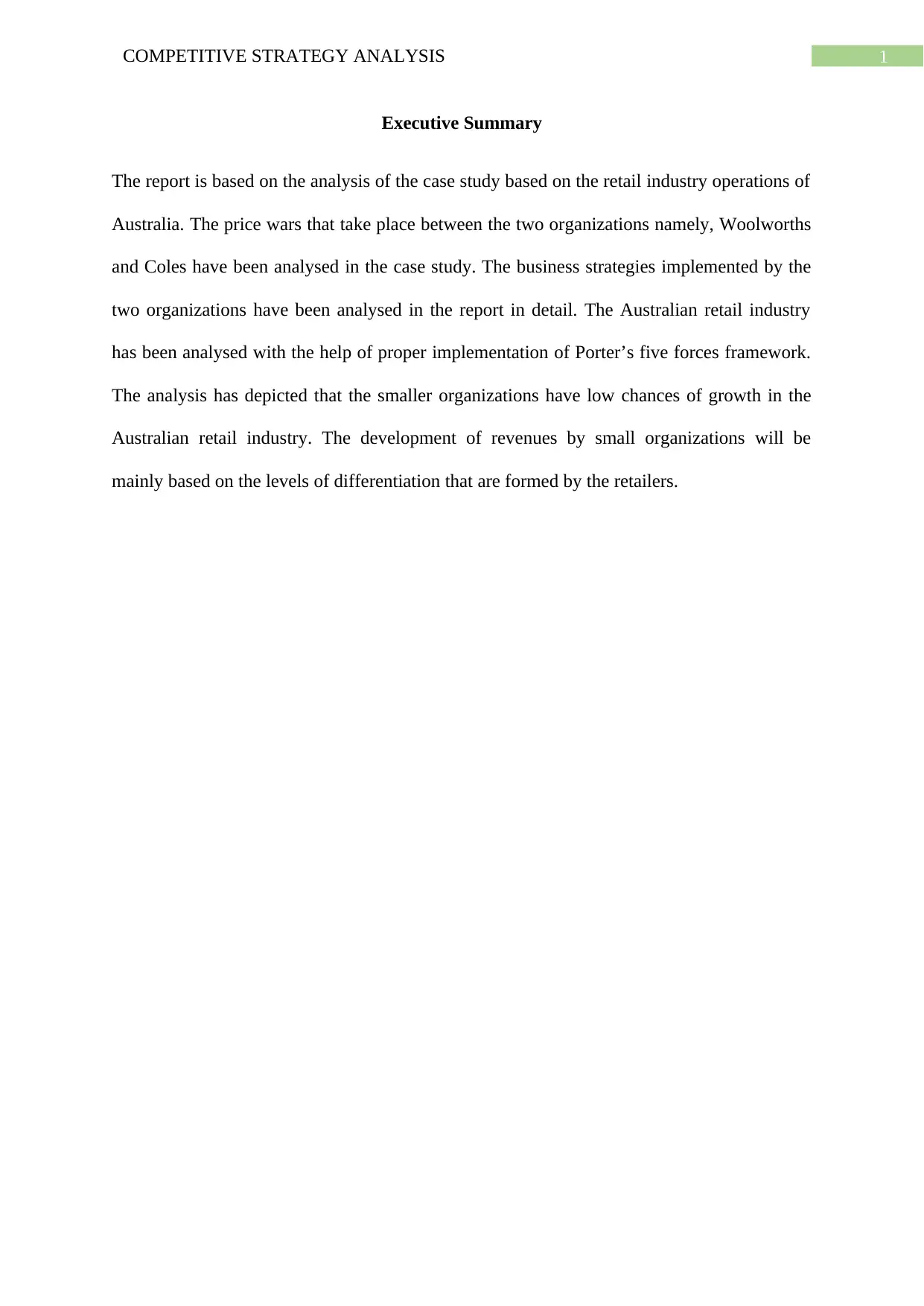
1COMPETITIVE STRATEGY ANALYSIS
Executive Summary
The report is based on the analysis of the case study based on the retail industry operations of
Australia. The price wars that take place between the two organizations namely, Woolworths
and Coles have been analysed in the case study. The business strategies implemented by the
two organizations have been analysed in the report in detail. The Australian retail industry
has been analysed with the help of proper implementation of Porter’s five forces framework.
The analysis has depicted that the smaller organizations have low chances of growth in the
Australian retail industry. The development of revenues by small organizations will be
mainly based on the levels of differentiation that are formed by the retailers.
Executive Summary
The report is based on the analysis of the case study based on the retail industry operations of
Australia. The price wars that take place between the two organizations namely, Woolworths
and Coles have been analysed in the case study. The business strategies implemented by the
two organizations have been analysed in the report in detail. The Australian retail industry
has been analysed with the help of proper implementation of Porter’s five forces framework.
The analysis has depicted that the smaller organizations have low chances of growth in the
Australian retail industry. The development of revenues by small organizations will be
mainly based on the levels of differentiation that are formed by the retailers.

2COMPETITIVE STRATEGY ANALYSIS
Table of Contents
Introduction....................................................................................................................3
Summary of the case study............................................................................................3
Identification of the strategic issues...............................................................................4
Business strategy based analysis....................................................................................6
Porter’s five forces analysis of Australian retail industry..............................................8
Conclusion......................................................................................................................9
References....................................................................................................................10
Table of Contents
Introduction....................................................................................................................3
Summary of the case study............................................................................................3
Identification of the strategic issues...............................................................................4
Business strategy based analysis....................................................................................6
Porter’s five forces analysis of Australian retail industry..............................................8
Conclusion......................................................................................................................9
References....................................................................................................................10
⊘ This is a preview!⊘
Do you want full access?
Subscribe today to unlock all pages.

Trusted by 1+ million students worldwide
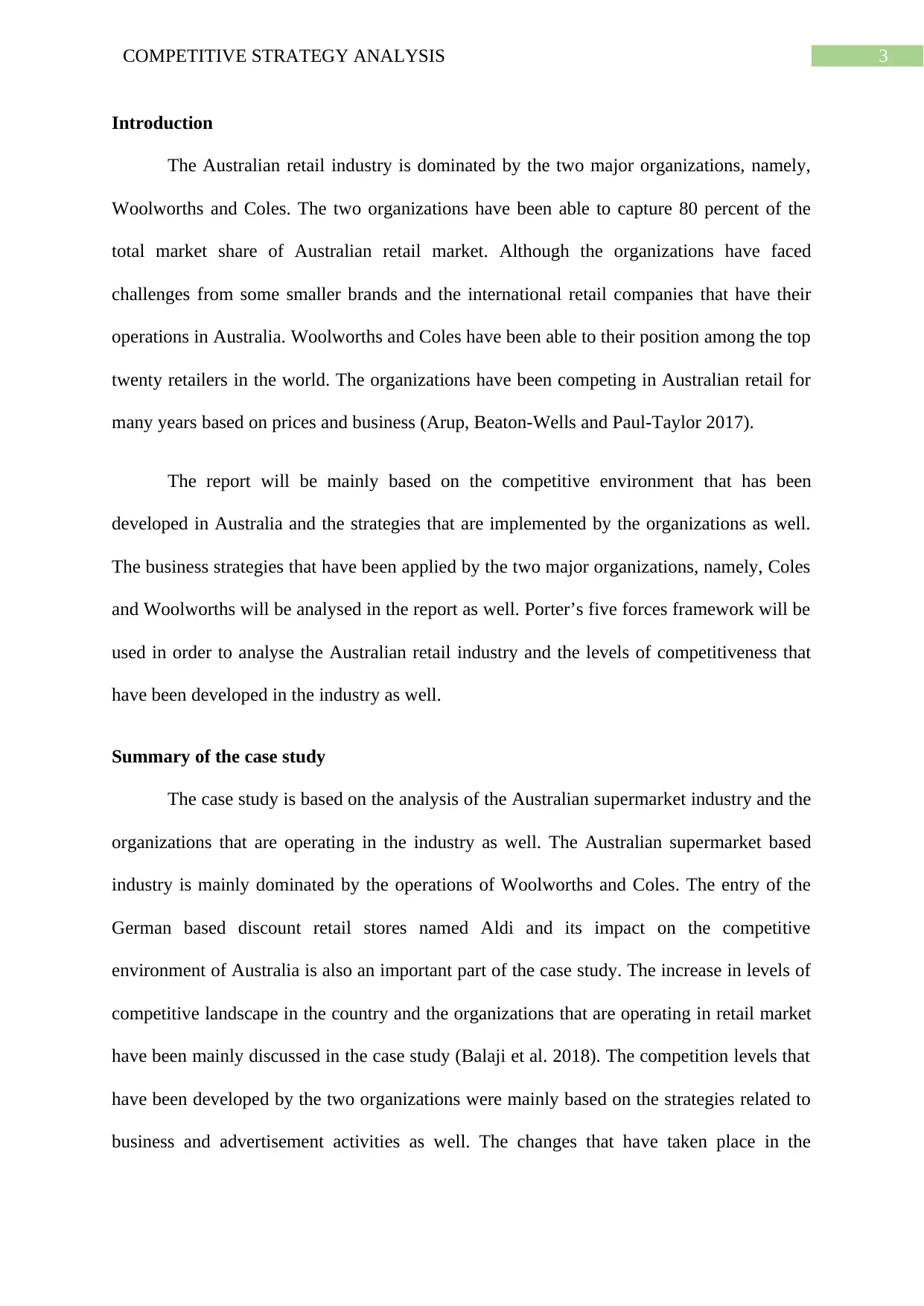
3COMPETITIVE STRATEGY ANALYSIS
Introduction
The Australian retail industry is dominated by the two major organizations, namely,
Woolworths and Coles. The two organizations have been able to capture 80 percent of the
total market share of Australian retail market. Although the organizations have faced
challenges from some smaller brands and the international retail companies that have their
operations in Australia. Woolworths and Coles have been able to their position among the top
twenty retailers in the world. The organizations have been competing in Australian retail for
many years based on prices and business (Arup, Beaton-Wells and Paul-Taylor 2017).
The report will be mainly based on the competitive environment that has been
developed in Australia and the strategies that are implemented by the organizations as well.
The business strategies that have been applied by the two major organizations, namely, Coles
and Woolworths will be analysed in the report as well. Porter’s five forces framework will be
used in order to analyse the Australian retail industry and the levels of competitiveness that
have been developed in the industry as well.
Summary of the case study
The case study is based on the analysis of the Australian supermarket industry and the
organizations that are operating in the industry as well. The Australian supermarket based
industry is mainly dominated by the operations of Woolworths and Coles. The entry of the
German based discount retail stores named Aldi and its impact on the competitive
environment of Australia is also an important part of the case study. The increase in levels of
competitive landscape in the country and the organizations that are operating in retail market
have been mainly discussed in the case study (Balaji et al. 2018). The competition levels that
have been developed by the two organizations were mainly based on the strategies related to
business and advertisement activities as well. The changes that have taken place in the
Introduction
The Australian retail industry is dominated by the two major organizations, namely,
Woolworths and Coles. The two organizations have been able to capture 80 percent of the
total market share of Australian retail market. Although the organizations have faced
challenges from some smaller brands and the international retail companies that have their
operations in Australia. Woolworths and Coles have been able to their position among the top
twenty retailers in the world. The organizations have been competing in Australian retail for
many years based on prices and business (Arup, Beaton-Wells and Paul-Taylor 2017).
The report will be mainly based on the competitive environment that has been
developed in Australia and the strategies that are implemented by the organizations as well.
The business strategies that have been applied by the two major organizations, namely, Coles
and Woolworths will be analysed in the report as well. Porter’s five forces framework will be
used in order to analyse the Australian retail industry and the levels of competitiveness that
have been developed in the industry as well.
Summary of the case study
The case study is based on the analysis of the Australian supermarket industry and the
organizations that are operating in the industry as well. The Australian supermarket based
industry is mainly dominated by the operations of Woolworths and Coles. The entry of the
German based discount retail stores named Aldi and its impact on the competitive
environment of Australia is also an important part of the case study. The increase in levels of
competitive landscape in the country and the organizations that are operating in retail market
have been mainly discussed in the case study (Balaji et al. 2018). The competition levels that
have been developed by the two organizations were mainly based on the strategies related to
business and advertisement activities as well. The changes that have taken place in the
Paraphrase This Document
Need a fresh take? Get an instant paraphrase of this document with our AI Paraphraser
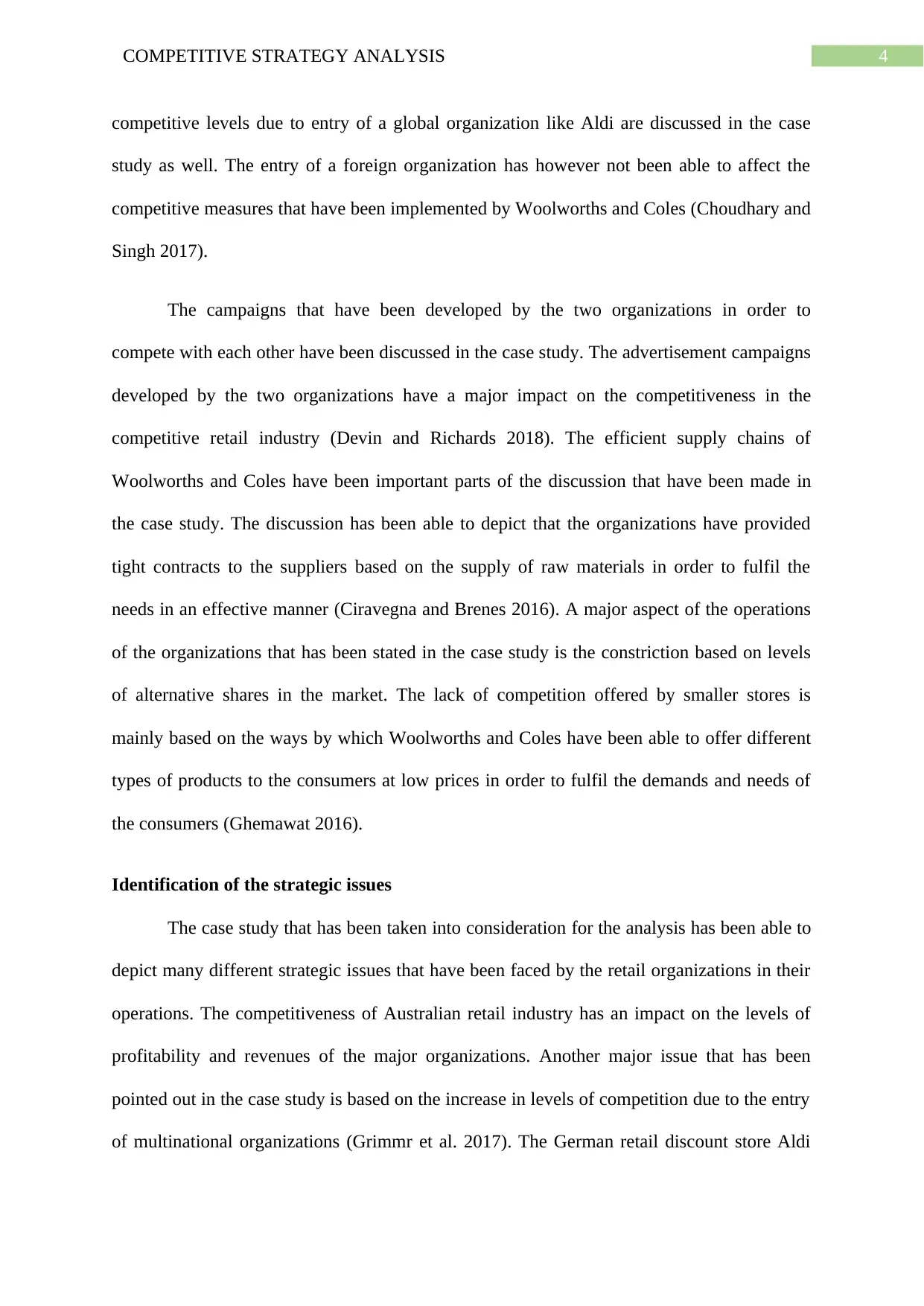
4COMPETITIVE STRATEGY ANALYSIS
competitive levels due to entry of a global organization like Aldi are discussed in the case
study as well. The entry of a foreign organization has however not been able to affect the
competitive measures that have been implemented by Woolworths and Coles (Choudhary and
Singh 2017).
The campaigns that have been developed by the two organizations in order to
compete with each other have been discussed in the case study. The advertisement campaigns
developed by the two organizations have a major impact on the competitiveness in the
competitive retail industry (Devin and Richards 2018). The efficient supply chains of
Woolworths and Coles have been important parts of the discussion that have been made in
the case study. The discussion has been able to depict that the organizations have provided
tight contracts to the suppliers based on the supply of raw materials in order to fulfil the
needs in an effective manner (Ciravegna and Brenes 2016). A major aspect of the operations
of the organizations that has been stated in the case study is the constriction based on levels
of alternative shares in the market. The lack of competition offered by smaller stores is
mainly based on the ways by which Woolworths and Coles have been able to offer different
types of products to the consumers at low prices in order to fulfil the demands and needs of
the consumers (Ghemawat 2016).
Identification of the strategic issues
The case study that has been taken into consideration for the analysis has been able to
depict many different strategic issues that have been faced by the retail organizations in their
operations. The competitiveness of Australian retail industry has an impact on the levels of
profitability and revenues of the major organizations. Another major issue that has been
pointed out in the case study is based on the increase in levels of competition due to the entry
of multinational organizations (Grimmr et al. 2017). The German retail discount store Aldi
competitive levels due to entry of a global organization like Aldi are discussed in the case
study as well. The entry of a foreign organization has however not been able to affect the
competitive measures that have been implemented by Woolworths and Coles (Choudhary and
Singh 2017).
The campaigns that have been developed by the two organizations in order to
compete with each other have been discussed in the case study. The advertisement campaigns
developed by the two organizations have a major impact on the competitiveness in the
competitive retail industry (Devin and Richards 2018). The efficient supply chains of
Woolworths and Coles have been important parts of the discussion that have been made in
the case study. The discussion has been able to depict that the organizations have provided
tight contracts to the suppliers based on the supply of raw materials in order to fulfil the
needs in an effective manner (Ciravegna and Brenes 2016). A major aspect of the operations
of the organizations that has been stated in the case study is the constriction based on levels
of alternative shares in the market. The lack of competition offered by smaller stores is
mainly based on the ways by which Woolworths and Coles have been able to offer different
types of products to the consumers at low prices in order to fulfil the demands and needs of
the consumers (Ghemawat 2016).
Identification of the strategic issues
The case study that has been taken into consideration for the analysis has been able to
depict many different strategic issues that have been faced by the retail organizations in their
operations. The competitiveness of Australian retail industry has an impact on the levels of
profitability and revenues of the major organizations. Another major issue that has been
pointed out in the case study is based on the increase in levels of competition due to the entry
of multinational organizations (Grimmr et al. 2017). The German retail discount store Aldi
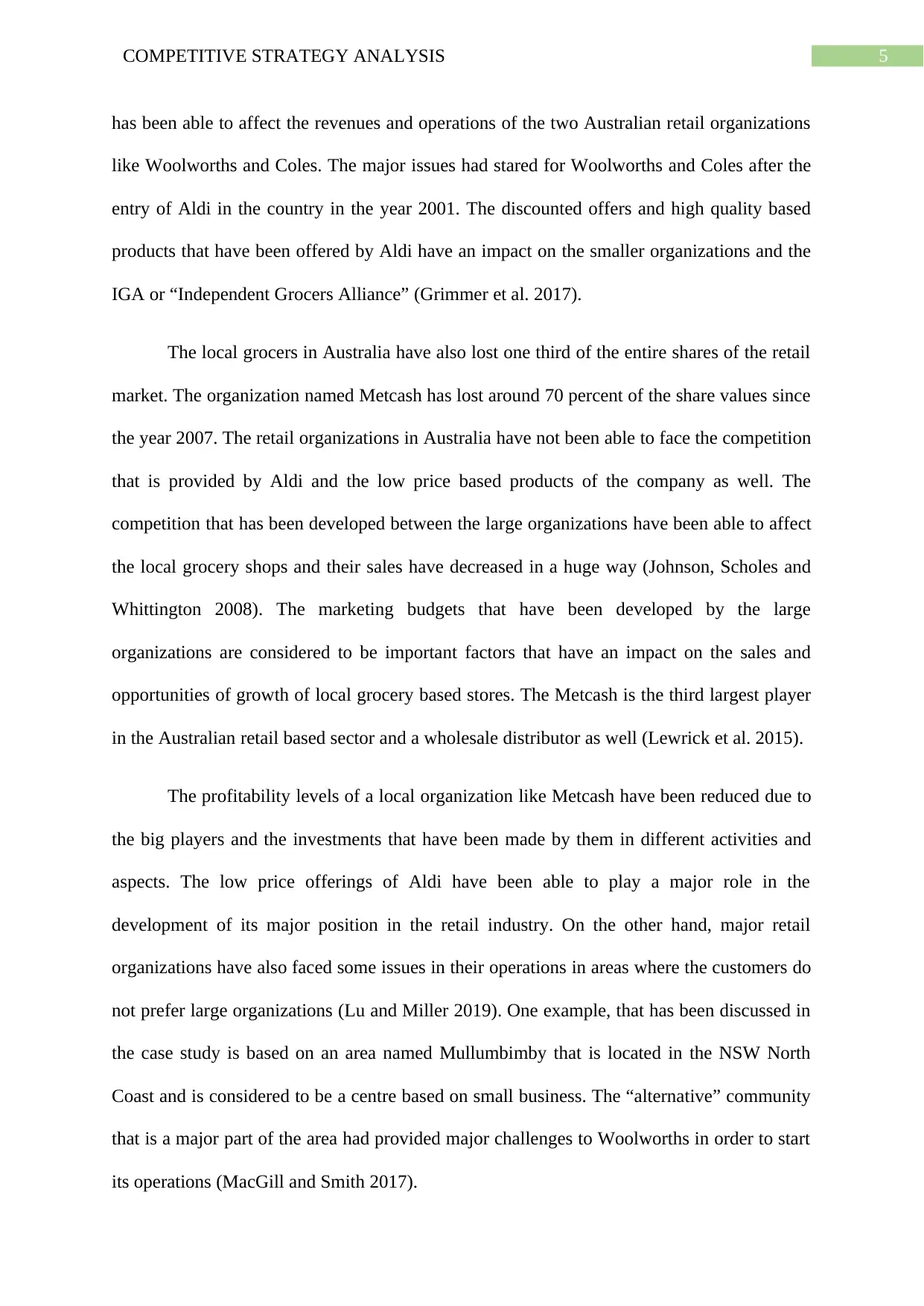
5COMPETITIVE STRATEGY ANALYSIS
has been able to affect the revenues and operations of the two Australian retail organizations
like Woolworths and Coles. The major issues had stared for Woolworths and Coles after the
entry of Aldi in the country in the year 2001. The discounted offers and high quality based
products that have been offered by Aldi have an impact on the smaller organizations and the
IGA or “Independent Grocers Alliance” (Grimmer et al. 2017).
The local grocers in Australia have also lost one third of the entire shares of the retail
market. The organization named Metcash has lost around 70 percent of the share values since
the year 2007. The retail organizations in Australia have not been able to face the competition
that is provided by Aldi and the low price based products of the company as well. The
competition that has been developed between the large organizations have been able to affect
the local grocery shops and their sales have decreased in a huge way (Johnson, Scholes and
Whittington 2008). The marketing budgets that have been developed by the large
organizations are considered to be important factors that have an impact on the sales and
opportunities of growth of local grocery based stores. The Metcash is the third largest player
in the Australian retail based sector and a wholesale distributor as well (Lewrick et al. 2015).
The profitability levels of a local organization like Metcash have been reduced due to
the big players and the investments that have been made by them in different activities and
aspects. The low price offerings of Aldi have been able to play a major role in the
development of its major position in the retail industry. On the other hand, major retail
organizations have also faced some issues in their operations in areas where the customers do
not prefer large organizations (Lu and Miller 2019). One example, that has been discussed in
the case study is based on an area named Mullumbimby that is located in the NSW North
Coast and is considered to be a centre based on small business. The “alternative” community
that is a major part of the area had provided major challenges to Woolworths in order to start
its operations (MacGill and Smith 2017).
has been able to affect the revenues and operations of the two Australian retail organizations
like Woolworths and Coles. The major issues had stared for Woolworths and Coles after the
entry of Aldi in the country in the year 2001. The discounted offers and high quality based
products that have been offered by Aldi have an impact on the smaller organizations and the
IGA or “Independent Grocers Alliance” (Grimmer et al. 2017).
The local grocers in Australia have also lost one third of the entire shares of the retail
market. The organization named Metcash has lost around 70 percent of the share values since
the year 2007. The retail organizations in Australia have not been able to face the competition
that is provided by Aldi and the low price based products of the company as well. The
competition that has been developed between the large organizations have been able to affect
the local grocery shops and their sales have decreased in a huge way (Johnson, Scholes and
Whittington 2008). The marketing budgets that have been developed by the large
organizations are considered to be important factors that have an impact on the sales and
opportunities of growth of local grocery based stores. The Metcash is the third largest player
in the Australian retail based sector and a wholesale distributor as well (Lewrick et al. 2015).
The profitability levels of a local organization like Metcash have been reduced due to
the big players and the investments that have been made by them in different activities and
aspects. The low price offerings of Aldi have been able to play a major role in the
development of its major position in the retail industry. On the other hand, major retail
organizations have also faced some issues in their operations in areas where the customers do
not prefer large organizations (Lu and Miller 2019). One example, that has been discussed in
the case study is based on an area named Mullumbimby that is located in the NSW North
Coast and is considered to be a centre based on small business. The “alternative” community
that is a major part of the area had provided major challenges to Woolworths in order to start
its operations (MacGill and Smith 2017).
⊘ This is a preview!⊘
Do you want full access?
Subscribe today to unlock all pages.

Trusted by 1+ million students worldwide
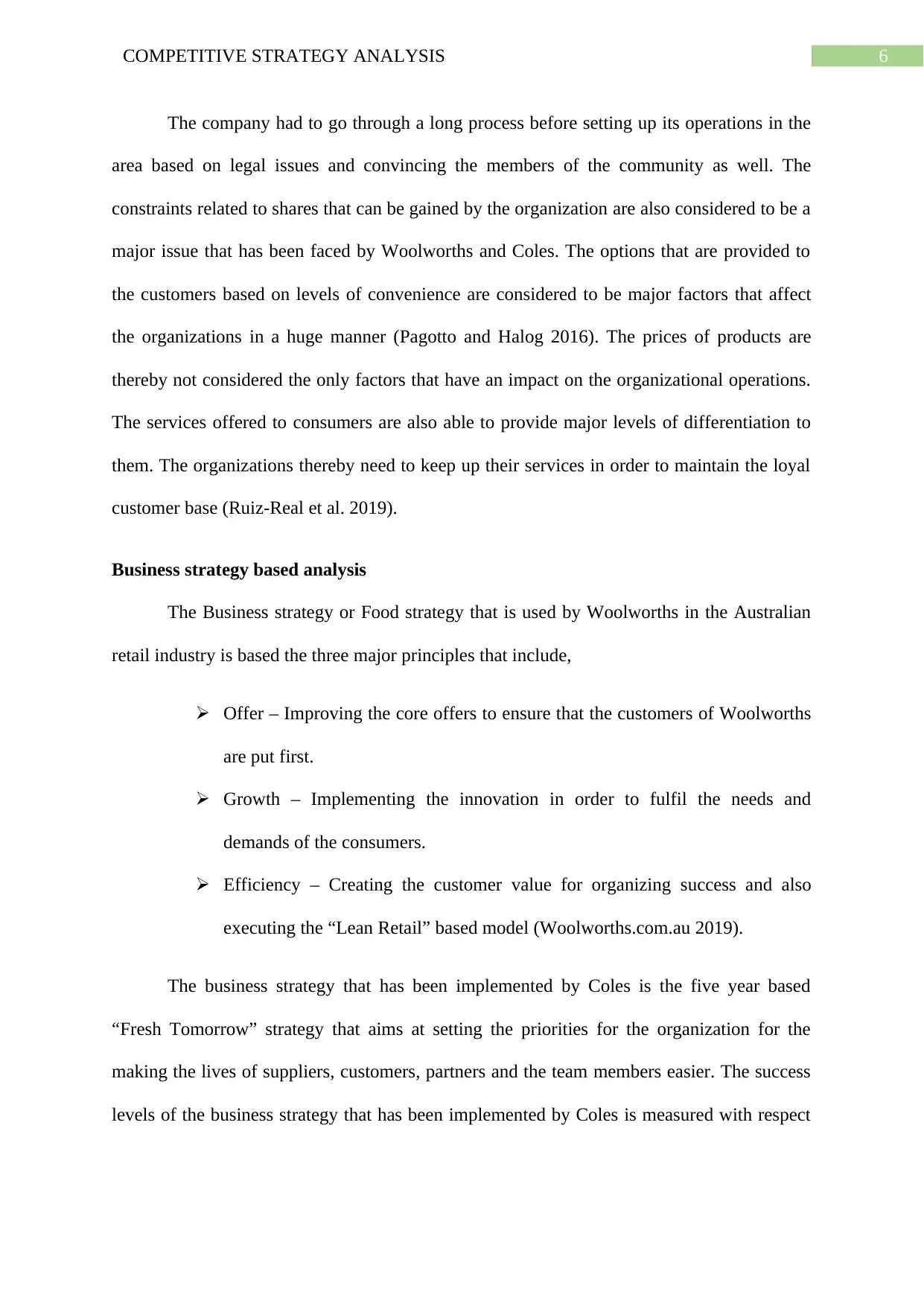
6COMPETITIVE STRATEGY ANALYSIS
The company had to go through a long process before setting up its operations in the
area based on legal issues and convincing the members of the community as well. The
constraints related to shares that can be gained by the organization are also considered to be a
major issue that has been faced by Woolworths and Coles. The options that are provided to
the customers based on levels of convenience are considered to be major factors that affect
the organizations in a huge manner (Pagotto and Halog 2016). The prices of products are
thereby not considered the only factors that have an impact on the organizational operations.
The services offered to consumers are also able to provide major levels of differentiation to
them. The organizations thereby need to keep up their services in order to maintain the loyal
customer base (Ruiz-Real et al. 2019).
Business strategy based analysis
The Business strategy or Food strategy that is used by Woolworths in the Australian
retail industry is based the three major principles that include,
Offer – Improving the core offers to ensure that the customers of Woolworths
are put first.
Growth – Implementing the innovation in order to fulfil the needs and
demands of the consumers.
Efficiency – Creating the customer value for organizing success and also
executing the “Lean Retail” based model (Woolworths.com.au 2019).
The business strategy that has been implemented by Coles is the five year based
“Fresh Tomorrow” strategy that aims at setting the priorities for the organization for the
making the lives of suppliers, customers, partners and the team members easier. The success
levels of the business strategy that has been implemented by Coles is measured with respect
The company had to go through a long process before setting up its operations in the
area based on legal issues and convincing the members of the community as well. The
constraints related to shares that can be gained by the organization are also considered to be a
major issue that has been faced by Woolworths and Coles. The options that are provided to
the customers based on levels of convenience are considered to be major factors that affect
the organizations in a huge manner (Pagotto and Halog 2016). The prices of products are
thereby not considered the only factors that have an impact on the organizational operations.
The services offered to consumers are also able to provide major levels of differentiation to
them. The organizations thereby need to keep up their services in order to maintain the loyal
customer base (Ruiz-Real et al. 2019).
Business strategy based analysis
The Business strategy or Food strategy that is used by Woolworths in the Australian
retail industry is based the three major principles that include,
Offer – Improving the core offers to ensure that the customers of Woolworths
are put first.
Growth – Implementing the innovation in order to fulfil the needs and
demands of the consumers.
Efficiency – Creating the customer value for organizing success and also
executing the “Lean Retail” based model (Woolworths.com.au 2019).
The business strategy that has been implemented by Coles is the five year based
“Fresh Tomorrow” strategy that aims at setting the priorities for the organization for the
making the lives of suppliers, customers, partners and the team members easier. The success
levels of the business strategy that has been implemented by Coles is measured with respect
Paraphrase This Document
Need a fresh take? Get an instant paraphrase of this document with our AI Paraphraser
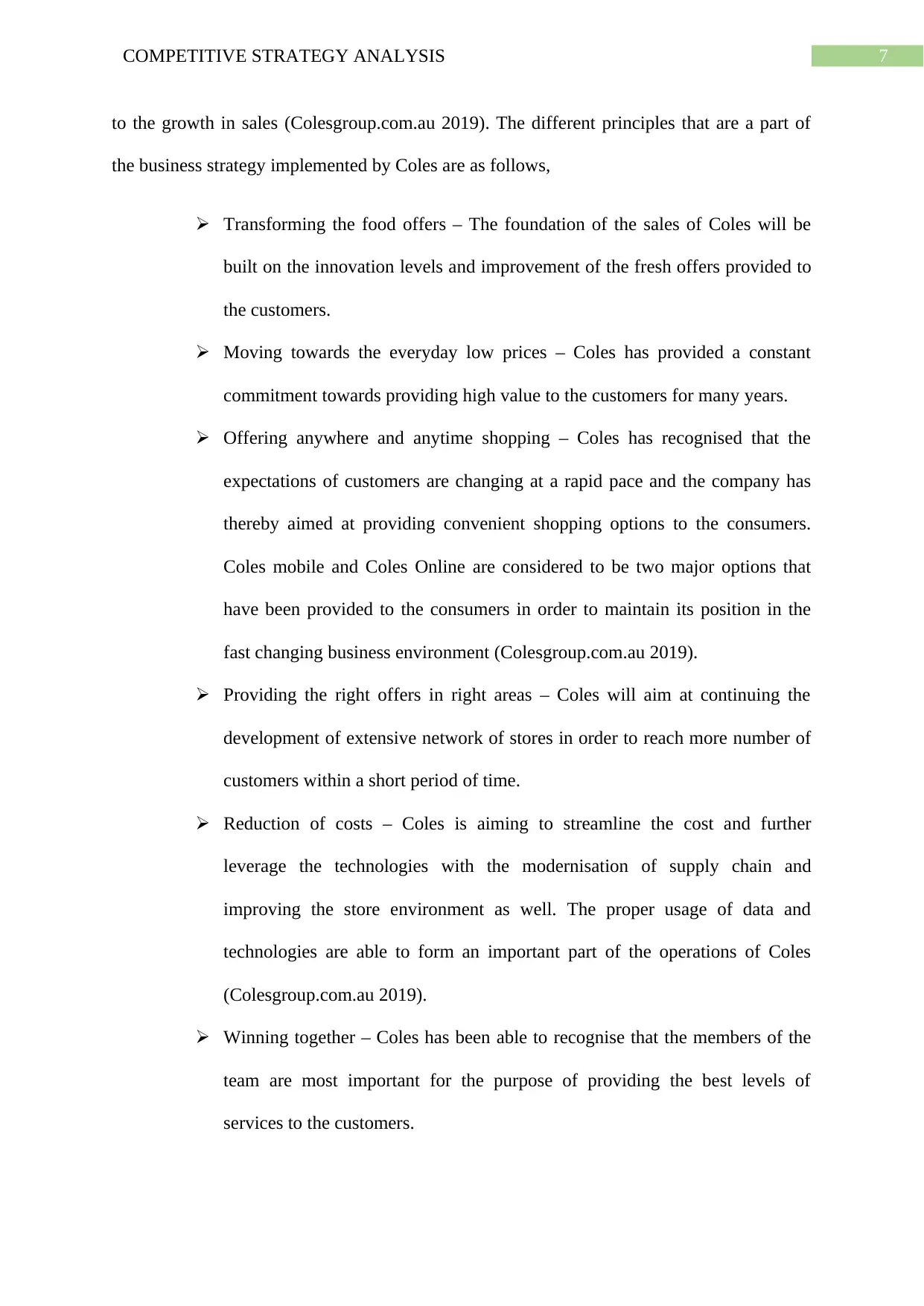
7COMPETITIVE STRATEGY ANALYSIS
to the growth in sales (Colesgroup.com.au 2019). The different principles that are a part of
the business strategy implemented by Coles are as follows,
Transforming the food offers – The foundation of the sales of Coles will be
built on the innovation levels and improvement of the fresh offers provided to
the customers.
Moving towards the everyday low prices – Coles has provided a constant
commitment towards providing high value to the customers for many years.
Offering anywhere and anytime shopping – Coles has recognised that the
expectations of customers are changing at a rapid pace and the company has
thereby aimed at providing convenient shopping options to the consumers.
Coles mobile and Coles Online are considered to be two major options that
have been provided to the consumers in order to maintain its position in the
fast changing business environment (Colesgroup.com.au 2019).
Providing the right offers in right areas – Coles will aim at continuing the
development of extensive network of stores in order to reach more number of
customers within a short period of time.
Reduction of costs – Coles is aiming to streamline the cost and further
leverage the technologies with the modernisation of supply chain and
improving the store environment as well. The proper usage of data and
technologies are able to form an important part of the operations of Coles
(Colesgroup.com.au 2019).
Winning together – Coles has been able to recognise that the members of the
team are most important for the purpose of providing the best levels of
services to the customers.
to the growth in sales (Colesgroup.com.au 2019). The different principles that are a part of
the business strategy implemented by Coles are as follows,
Transforming the food offers – The foundation of the sales of Coles will be
built on the innovation levels and improvement of the fresh offers provided to
the customers.
Moving towards the everyday low prices – Coles has provided a constant
commitment towards providing high value to the customers for many years.
Offering anywhere and anytime shopping – Coles has recognised that the
expectations of customers are changing at a rapid pace and the company has
thereby aimed at providing convenient shopping options to the consumers.
Coles mobile and Coles Online are considered to be two major options that
have been provided to the consumers in order to maintain its position in the
fast changing business environment (Colesgroup.com.au 2019).
Providing the right offers in right areas – Coles will aim at continuing the
development of extensive network of stores in order to reach more number of
customers within a short period of time.
Reduction of costs – Coles is aiming to streamline the cost and further
leverage the technologies with the modernisation of supply chain and
improving the store environment as well. The proper usage of data and
technologies are able to form an important part of the operations of Coles
(Colesgroup.com.au 2019).
Winning together – Coles has been able to recognise that the members of the
team are most important for the purpose of providing the best levels of
services to the customers.
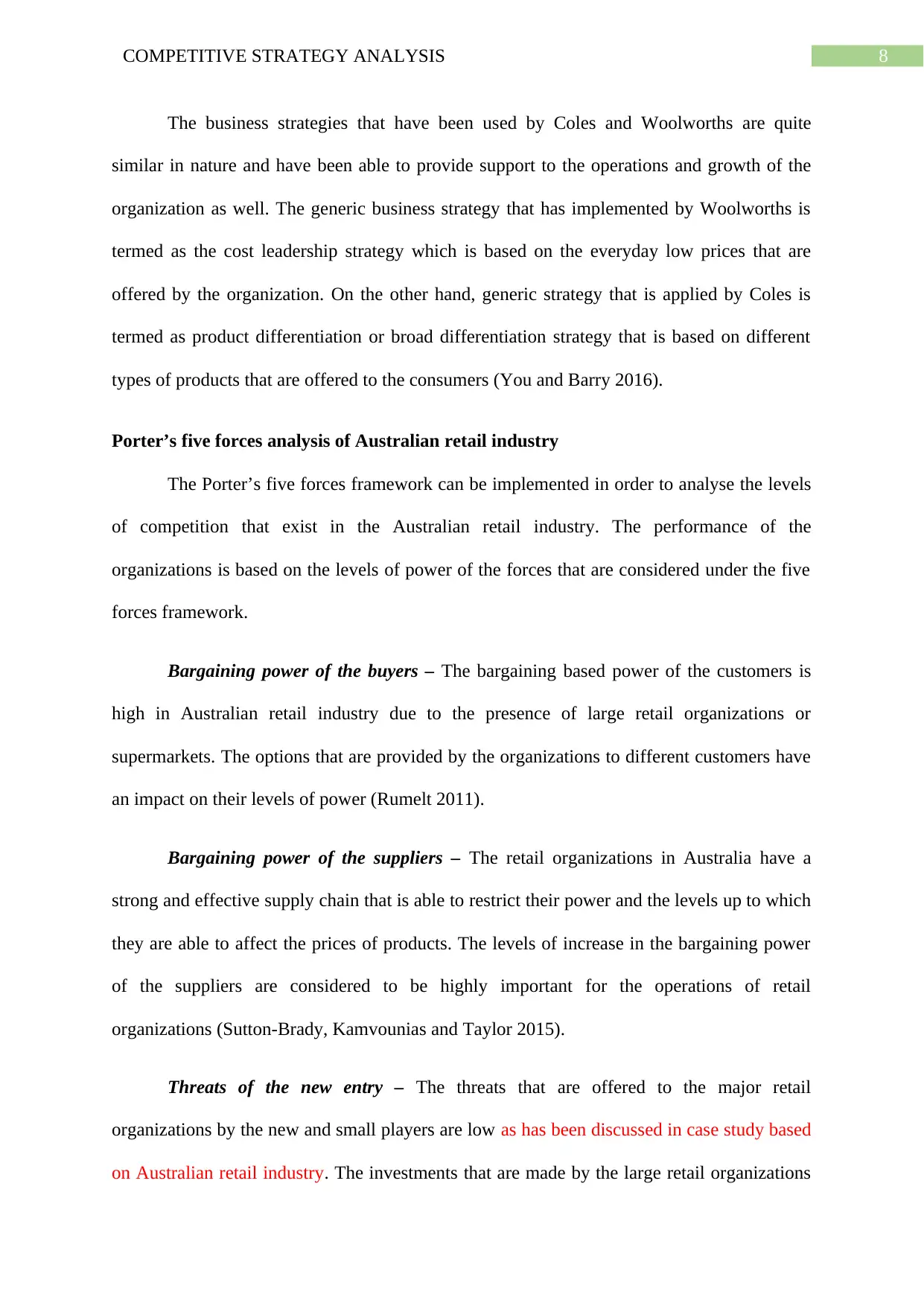
8COMPETITIVE STRATEGY ANALYSIS
The business strategies that have been used by Coles and Woolworths are quite
similar in nature and have been able to provide support to the operations and growth of the
organization as well. The generic business strategy that has implemented by Woolworths is
termed as the cost leadership strategy which is based on the everyday low prices that are
offered by the organization. On the other hand, generic strategy that is applied by Coles is
termed as product differentiation or broad differentiation strategy that is based on different
types of products that are offered to the consumers (You and Barry 2016).
Porter’s five forces analysis of Australian retail industry
The Porter’s five forces framework can be implemented in order to analyse the levels
of competition that exist in the Australian retail industry. The performance of the
organizations is based on the levels of power of the forces that are considered under the five
forces framework.
Bargaining power of the buyers – The bargaining based power of the customers is
high in Australian retail industry due to the presence of large retail organizations or
supermarkets. The options that are provided by the organizations to different customers have
an impact on their levels of power (Rumelt 2011).
Bargaining power of the suppliers – The retail organizations in Australia have a
strong and effective supply chain that is able to restrict their power and the levels up to which
they are able to affect the prices of products. The levels of increase in the bargaining power
of the suppliers are considered to be highly important for the operations of retail
organizations (Sutton-Brady, Kamvounias and Taylor 2015).
Threats of the new entry – The threats that are offered to the major retail
organizations by the new and small players are low as has been discussed in case study based
on Australian retail industry. The investments that are made by the large retail organizations
The business strategies that have been used by Coles and Woolworths are quite
similar in nature and have been able to provide support to the operations and growth of the
organization as well. The generic business strategy that has implemented by Woolworths is
termed as the cost leadership strategy which is based on the everyday low prices that are
offered by the organization. On the other hand, generic strategy that is applied by Coles is
termed as product differentiation or broad differentiation strategy that is based on different
types of products that are offered to the consumers (You and Barry 2016).
Porter’s five forces analysis of Australian retail industry
The Porter’s five forces framework can be implemented in order to analyse the levels
of competition that exist in the Australian retail industry. The performance of the
organizations is based on the levels of power of the forces that are considered under the five
forces framework.
Bargaining power of the buyers – The bargaining based power of the customers is
high in Australian retail industry due to the presence of large retail organizations or
supermarkets. The options that are provided by the organizations to different customers have
an impact on their levels of power (Rumelt 2011).
Bargaining power of the suppliers – The retail organizations in Australia have a
strong and effective supply chain that is able to restrict their power and the levels up to which
they are able to affect the prices of products. The levels of increase in the bargaining power
of the suppliers are considered to be highly important for the operations of retail
organizations (Sutton-Brady, Kamvounias and Taylor 2015).
Threats of the new entry – The threats that are offered to the major retail
organizations by the new and small players are low as has been discussed in case study based
on Australian retail industry. The investments that are made by the large retail organizations
⊘ This is a preview!⊘
Do you want full access?
Subscribe today to unlock all pages.

Trusted by 1+ million students worldwide
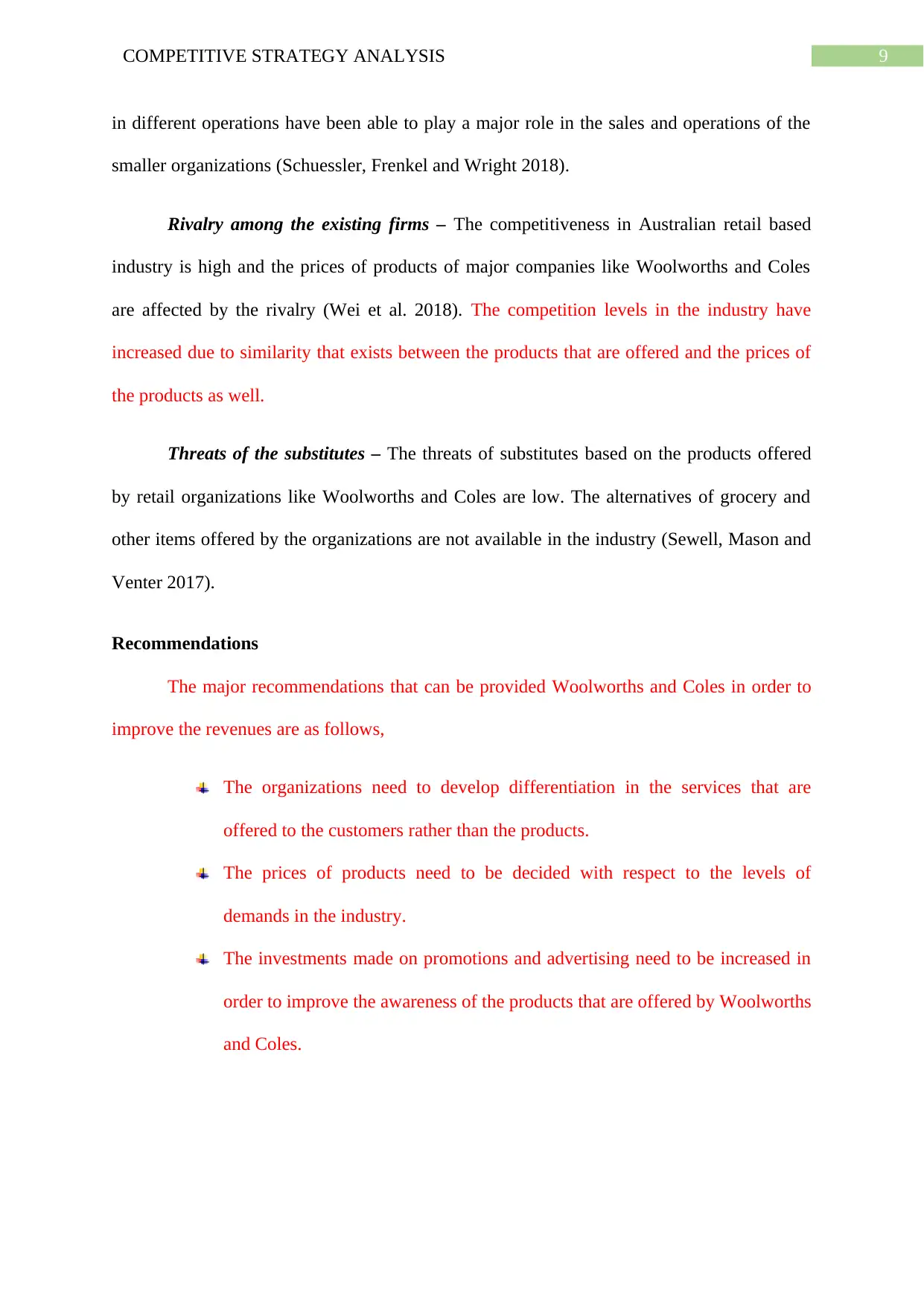
9COMPETITIVE STRATEGY ANALYSIS
in different operations have been able to play a major role in the sales and operations of the
smaller organizations (Schuessler, Frenkel and Wright 2018).
Rivalry among the existing firms – The competitiveness in Australian retail based
industry is high and the prices of products of major companies like Woolworths and Coles
are affected by the rivalry (Wei et al. 2018). The competition levels in the industry have
increased due to similarity that exists between the products that are offered and the prices of
the products as well.
Threats of the substitutes – The threats of substitutes based on the products offered
by retail organizations like Woolworths and Coles are low. The alternatives of grocery and
other items offered by the organizations are not available in the industry (Sewell, Mason and
Venter 2017).
Recommendations
The major recommendations that can be provided Woolworths and Coles in order to
improve the revenues are as follows,
The organizations need to develop differentiation in the services that are
offered to the customers rather than the products.
The prices of products need to be decided with respect to the levels of
demands in the industry.
The investments made on promotions and advertising need to be increased in
order to improve the awareness of the products that are offered by Woolworths
and Coles.
in different operations have been able to play a major role in the sales and operations of the
smaller organizations (Schuessler, Frenkel and Wright 2018).
Rivalry among the existing firms – The competitiveness in Australian retail based
industry is high and the prices of products of major companies like Woolworths and Coles
are affected by the rivalry (Wei et al. 2018). The competition levels in the industry have
increased due to similarity that exists between the products that are offered and the prices of
the products as well.
Threats of the substitutes – The threats of substitutes based on the products offered
by retail organizations like Woolworths and Coles are low. The alternatives of grocery and
other items offered by the organizations are not available in the industry (Sewell, Mason and
Venter 2017).
Recommendations
The major recommendations that can be provided Woolworths and Coles in order to
improve the revenues are as follows,
The organizations need to develop differentiation in the services that are
offered to the customers rather than the products.
The prices of products need to be decided with respect to the levels of
demands in the industry.
The investments made on promotions and advertising need to be increased in
order to improve the awareness of the products that are offered by Woolworths
and Coles.
Paraphrase This Document
Need a fresh take? Get an instant paraphrase of this document with our AI Paraphraser
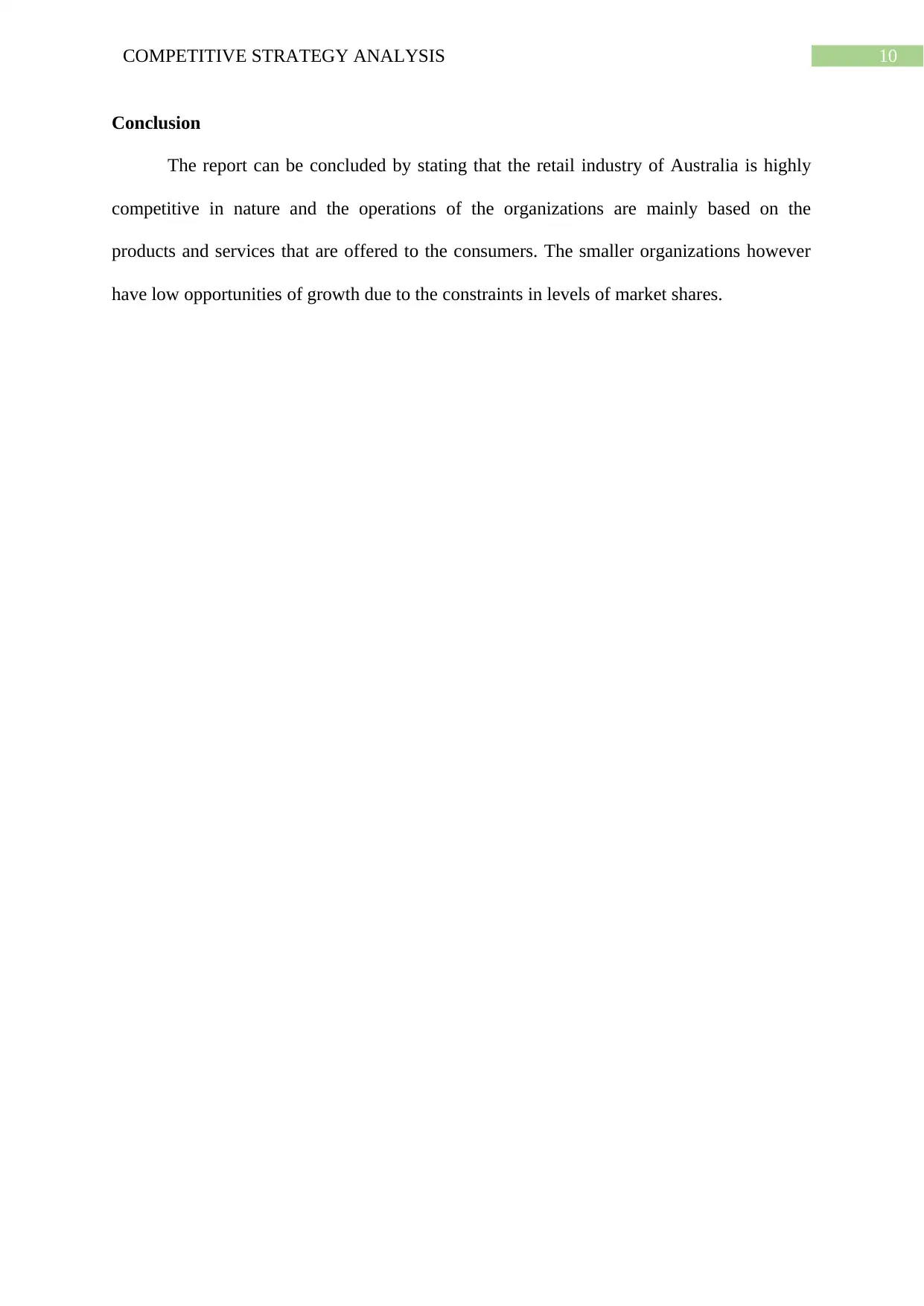
10COMPETITIVE STRATEGY ANALYSIS
Conclusion
The report can be concluded by stating that the retail industry of Australia is highly
competitive in nature and the operations of the organizations are mainly based on the
products and services that are offered to the consumers. The smaller organizations however
have low opportunities of growth due to the constraints in levels of market shares.
Conclusion
The report can be concluded by stating that the retail industry of Australia is highly
competitive in nature and the operations of the organizations are mainly based on the
products and services that are offered to the consumers. The smaller organizations however
have low opportunities of growth due to the constraints in levels of market shares.
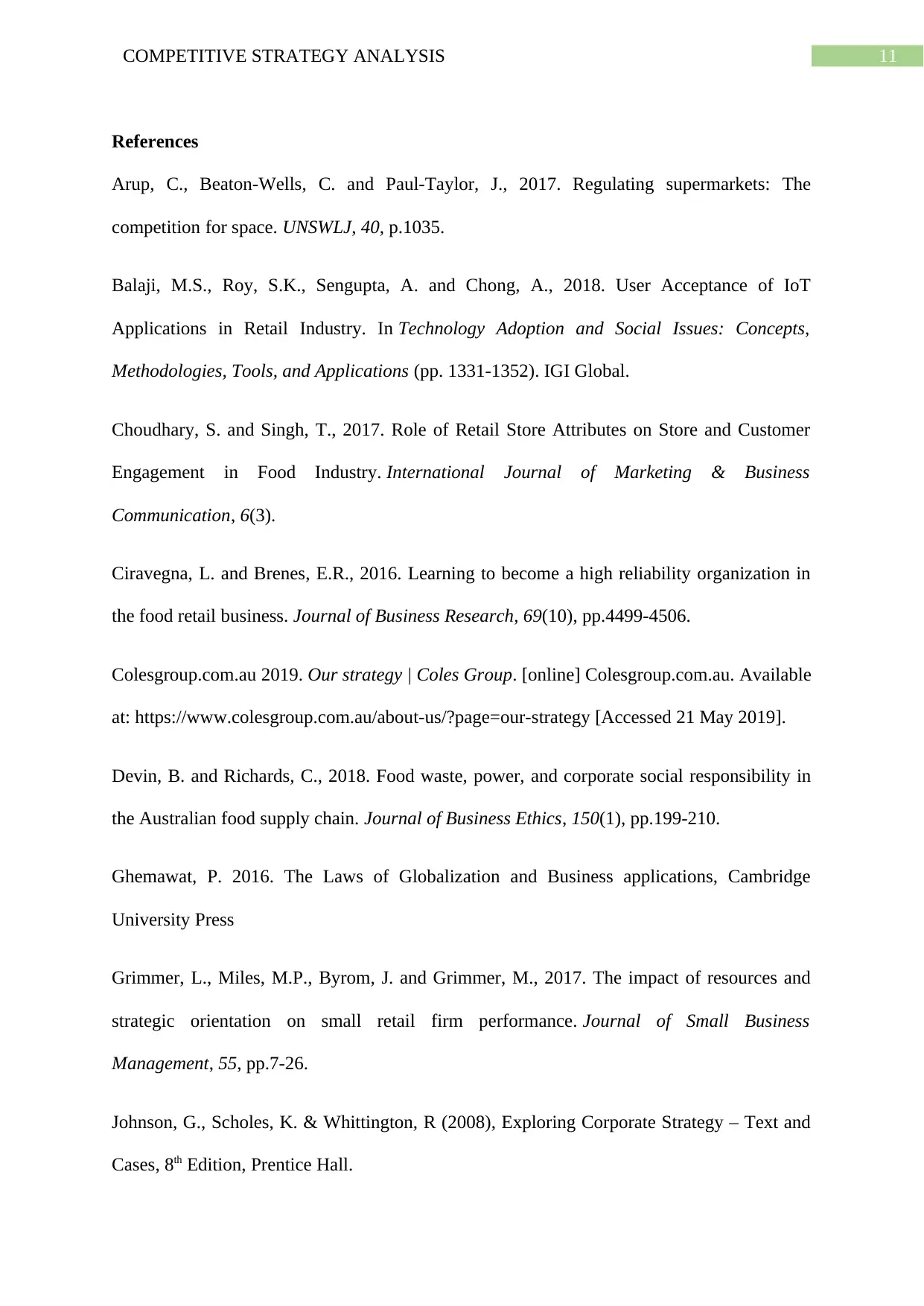
11COMPETITIVE STRATEGY ANALYSIS
References
Arup, C., Beaton-Wells, C. and Paul-Taylor, J., 2017. Regulating supermarkets: The
competition for space. UNSWLJ, 40, p.1035.
Balaji, M.S., Roy, S.K., Sengupta, A. and Chong, A., 2018. User Acceptance of IoT
Applications in Retail Industry. In Technology Adoption and Social Issues: Concepts,
Methodologies, Tools, and Applications (pp. 1331-1352). IGI Global.
Choudhary, S. and Singh, T., 2017. Role of Retail Store Attributes on Store and Customer
Engagement in Food Industry. International Journal of Marketing & Business
Communication, 6(3).
Ciravegna, L. and Brenes, E.R., 2016. Learning to become a high reliability organization in
the food retail business. Journal of Business Research, 69(10), pp.4499-4506.
Colesgroup.com.au 2019. Our strategy | Coles Group. [online] Colesgroup.com.au. Available
at: https://www.colesgroup.com.au/about-us/?page=our-strategy [Accessed 21 May 2019].
Devin, B. and Richards, C., 2018. Food waste, power, and corporate social responsibility in
the Australian food supply chain. Journal of Business Ethics, 150(1), pp.199-210.
Ghemawat, P. 2016. The Laws of Globalization and Business applications, Cambridge
University Press
Grimmer, L., Miles, M.P., Byrom, J. and Grimmer, M., 2017. The impact of resources and
strategic orientation on small retail firm performance. Journal of Small Business
Management, 55, pp.7-26.
Johnson, G., Scholes, K. & Whittington, R (2008), Exploring Corporate Strategy – Text and
Cases, 8th Edition, Prentice Hall.
References
Arup, C., Beaton-Wells, C. and Paul-Taylor, J., 2017. Regulating supermarkets: The
competition for space. UNSWLJ, 40, p.1035.
Balaji, M.S., Roy, S.K., Sengupta, A. and Chong, A., 2018. User Acceptance of IoT
Applications in Retail Industry. In Technology Adoption and Social Issues: Concepts,
Methodologies, Tools, and Applications (pp. 1331-1352). IGI Global.
Choudhary, S. and Singh, T., 2017. Role of Retail Store Attributes on Store and Customer
Engagement in Food Industry. International Journal of Marketing & Business
Communication, 6(3).
Ciravegna, L. and Brenes, E.R., 2016. Learning to become a high reliability organization in
the food retail business. Journal of Business Research, 69(10), pp.4499-4506.
Colesgroup.com.au 2019. Our strategy | Coles Group. [online] Colesgroup.com.au. Available
at: https://www.colesgroup.com.au/about-us/?page=our-strategy [Accessed 21 May 2019].
Devin, B. and Richards, C., 2018. Food waste, power, and corporate social responsibility in
the Australian food supply chain. Journal of Business Ethics, 150(1), pp.199-210.
Ghemawat, P. 2016. The Laws of Globalization and Business applications, Cambridge
University Press
Grimmer, L., Miles, M.P., Byrom, J. and Grimmer, M., 2017. The impact of resources and
strategic orientation on small retail firm performance. Journal of Small Business
Management, 55, pp.7-26.
Johnson, G., Scholes, K. & Whittington, R (2008), Exploring Corporate Strategy – Text and
Cases, 8th Edition, Prentice Hall.
⊘ This is a preview!⊘
Do you want full access?
Subscribe today to unlock all pages.

Trusted by 1+ million students worldwide
1 out of 14
Related Documents
Your All-in-One AI-Powered Toolkit for Academic Success.
+13062052269
info@desklib.com
Available 24*7 on WhatsApp / Email
![[object Object]](/_next/static/media/star-bottom.7253800d.svg)
Unlock your academic potential
Copyright © 2020–2025 A2Z Services. All Rights Reserved. Developed and managed by ZUCOL.




